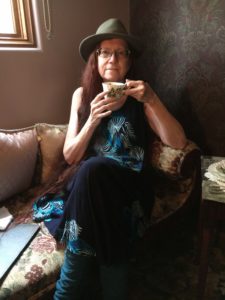 Recently the question of omniscient POV has come up in several classes, so I started reading some examples of it. One of the best I hit was Sherwood Smith’s Inda series. I figured, why not go to Sherwood and ask some questions about how she pulled that off.
Recently the question of omniscient POV has come up in several classes, so I started reading some examples of it. One of the best I hit was Sherwood Smith’s Inda series. I figured, why not go to Sherwood and ask some questions about how she pulled that off.
What drew you to using omniscient point of view for the Inda series? What sorts of stories work particularly well with that POV? Were there any models that you looked when working with it?
I had always written in omni. I’m a visual writer (with all its pluses and pitfalls), which means I see a movie in my head””not just dialogue but characters’ inner lives. Omni always seemed the easiest way to get that movie down.
But when I started selling, I was told to switch to limited third, which I had to learn.
Segue up a couple decades, I was desperate to escape the limitations of third, and omni was no longer (trigger doom music) Forbidden. I had to relearn omni, by which I mean consciously grasping the difference between omniscient voice and head-hopping. (Some readers will call omniscient voice head-hopping. My guess is that some of these readers might have had little exposure to early novels.)
To review omni, I went back to the eighteenth and nineteenth century books I’d grown up reading, with an eye to the development of narrative voice: I noted how Jane Austen invented the modern novel with her mostly-offstage narrator, which had been influenced by Henry Fielding‘s rudimentary narrative style in Tom Jones, and Samuel Richardson‘s experimentation in Clarissa. I reread William Thackeray‘s Vanity Fair, whose narrator strides right out on stage, breaking the fourth wall to directly address the audience.
I came to the conclusion that every novel, actually, has a narrator. Including those written in limited third or even camera-eye view. But many writers don’t recognize that. Maybe they don’t need to. Everybody’s process is different. For me, it’s a helpful rule or reminder for handling diegesis as well as mimesis, and how to incorporate elements like public, private, and intimate space (each with its discrete focus), how to slide into free indirect discourse, etc.
Anyway, with Inda””with any big, braided story””I find limited third so, um, limiting. It’s so difficult to get all the POVs in you want and not jerk the reader back and forth in time, or break the narrative into little scenes in order to properly isolate those POV changes. If you’ve got a narrator, and know why that narrator is telling the story, I think one can better see the entire structure of the novel, and determine how many POVs to use, where, and when.
What difficulties presented themselves as a result? What did you have to be mindful about as you were writing?
Slipping too frequently into diegesis, especially when tired, and summarizing what ought to be scenes. When I say tired, I don’t mean single sessions, though that is true, too. I mean those long months, even years, it takes to write a novel””sometimes forgetting it takes a few hours to read it. Another aspect to be mindful of is limiting the access to characters’ thoughts to those needed for not just the action through-line but the emotional through-line. And cut out all the other voices yammering, or they can proliferate fast into side-stories.
What issues did it present when rewriting?
Those side-stories. Also, figuring out when to let the narrator come forward.
Was there anything that surprised you about using it?
Not really, because I’d grown up writing omni. The surprise was the realization that all novels have narrators.
One of the biggest concerns about using omniscient POV is that readers have been trained to spot “head-hopping” as a flaw. Do you have any strategies for avoiding this?
Some readers are not going to like it no matter what. Maybe a matter of taste, or of training””if you’d grown up reading only first or third, omni can come as a surprise. I’ve heard readers say they won’t read first person, or second, or present tense, or omni. That’s a taste call. I think it makes it easier to get used to when the writer works to make certain that every shift or transition is grounded””that there are no floating pronouns so the reader is forced to go paging back for the antecedent. (And yeah, it’s so easy to screw up even when trying to focus on that specifically.)
What are you working on right now and what POV is it in?
A series, called the Young Allies, that will begin coming out from DAW next summer. It is all complete, and written in omni. Same narrator as Inda.
What’s the best entry point into your work if a reader’s looking for a book to start with? Inda or something else?
I guess that depends what type of story they are looking for? YAs I usually direct to Crown Duel, which is an early work, but it’s stayed in print since the nineties. (I recommend the ebook version though””it has fewer errors.) Then there is the four-book Inda series, for fantasy, and the ebook version of Exordium, a five book space opera I wrote with Dave Trowbridge.
—————————
For more about Sherwood Smith, visit her website at www.sherwoodsmith.net. Follow her on Twitter here.





